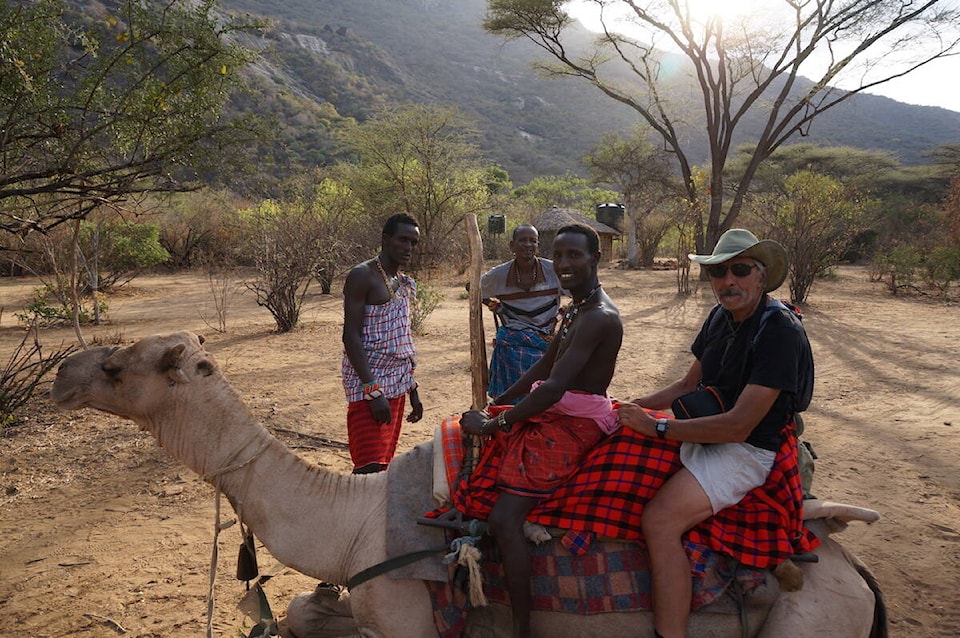Jon Turk started to realize he had a book in his hands when a Samburu village headsman handed him a club and asked if he knew how to neutralize a charging lion with it.
He released a book discussing the experience and more in Tracking Lions, Myth, and Wilderness in Samburu. It was published by Rocky Mountain Books on Sept. 26. His first traditional book launch event was held on Oct. 28 at the Fernie Seniors Center. He lives in Montana, but has spent about 28 winters in Fernie.
Turk, who has a long track record as an adventurer, was among the Samburu people of Kenya in August 2017 after agreeing to tag along on a scientific expedition to the region.
READ MORE: Jon Turk tells his global explorations … at home
He didn’t realize when he agreed to join the trip that it would end up relating so well to a question he had been pondering for some time: how to solve problems such as “global warming and population explosion and water scarcity” via what he calls a “consciousness revolution.” Such a revolution occurred around 70,000 years ago to our Homo sapiens ancestors and helped them overcome near-extinction, he said.
The common conception, Turk said, is that it was the use of tools that gave humans the cutting edge to survive. He challenges that view.
”The story, from modern archaeology, is that what happened first was art. It was symbolism. It was thinking about things that don’t exist. It was cooperation, it was dance, it was music.”
That consciousness and cultural revolution, he said, is what gave our Stone Age ancestors the will to survive.
Turk’s book addresses that larger question, weaving it within the narrative that unfolded during his month in Kenya.
“I went through effectively 70,000 years of evolution in a month,” Turk said.
The beginning of that sped-up evolutionary journey began when the village headsman handed him the club to use for self-defense against a lion.
“And now I’m walking through savanna heat in the day, the tracks are very fresh, there’s a lion out there. I have a wooden club. And first I get angry,” he said. There were guns and machetes around. The club seemed like a joke.
But he quickly realized that anger wasn’t going to help him get through the day.
“I have to reach another state of consciousness to survive.”
He and his companions stumbled upon a cow that had been eaten by the lion. They followed the tracks. Then, they found an even fresher kill: a warthog. Turk had to move from a mentality of anger and fear to one of “total alertness” and “total presence.”
They never found the lion, and Turk never got to use the club. But he did stumble upon the first narrative element that would carry his book idea into reality.
After that day, things calmed down. He spent time living and experiencing the cultural life of the Samburu people.
But it didn’t stay calm for long. There was an election happening in Nairobi. Things began to get dangerous again.
“All of a sudden, guns are starting to appear, and the friendly old night guard is displaced by a warrior with an AK47 and cross-cartridge belts and all that.”
He was suddenly facing a more modern problem: storytelling being used to fuel inter-group warfare.
He began to ponder the fact that he might end up dead for no good reason. He wondered what the potential attackers would have against him. And then he realized that they have stories in their heads about him. He was a symbol.
Turk’s book had then come to completion. The same storytelling tendency that he says was used in the Stone Age to unite people and give them power was now being used to create evil, he said.
It was too dangerous to leave the village using the regular road. The way home came from a nearby airstrip. He paid $300 to take a plane over the troubles.
Turk’s time in Kenya gave him the narrative and broad view of human history that solidified his book.
“Once you see and step back from the grand flow of human history, you can see our strengths and our weaknesses,” he said.
The agricultural, industrial, and computer revolutions have brought us far in many ways, Turk said, but have also landed us in deep trouble. We’re back to where we were 70,000 years ago in terms of needing to find a solution to survive, he said.
“And I call that new solution the consciousness revolution, where we have to go back to the fundamental ideas of love and community and cooperation and togetherness, and getting rid of these 21st century stories that are twisting our minds.”
Tracking Lions, Myth, and Wilderness in Samburu is Turk’s last book. It has two ratings on Amazon, both five stars.
For more information about Turk, visit his website here.
@fishynewswatch
josh.fischlin@thefreepress.ca
Like us on Facebook and follow us on Twitter.
